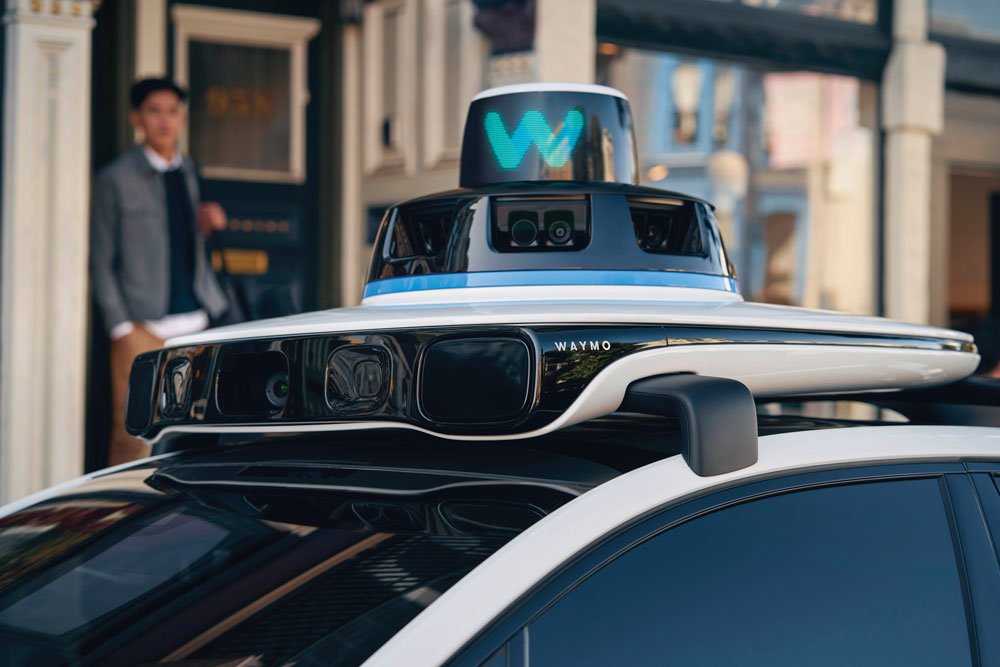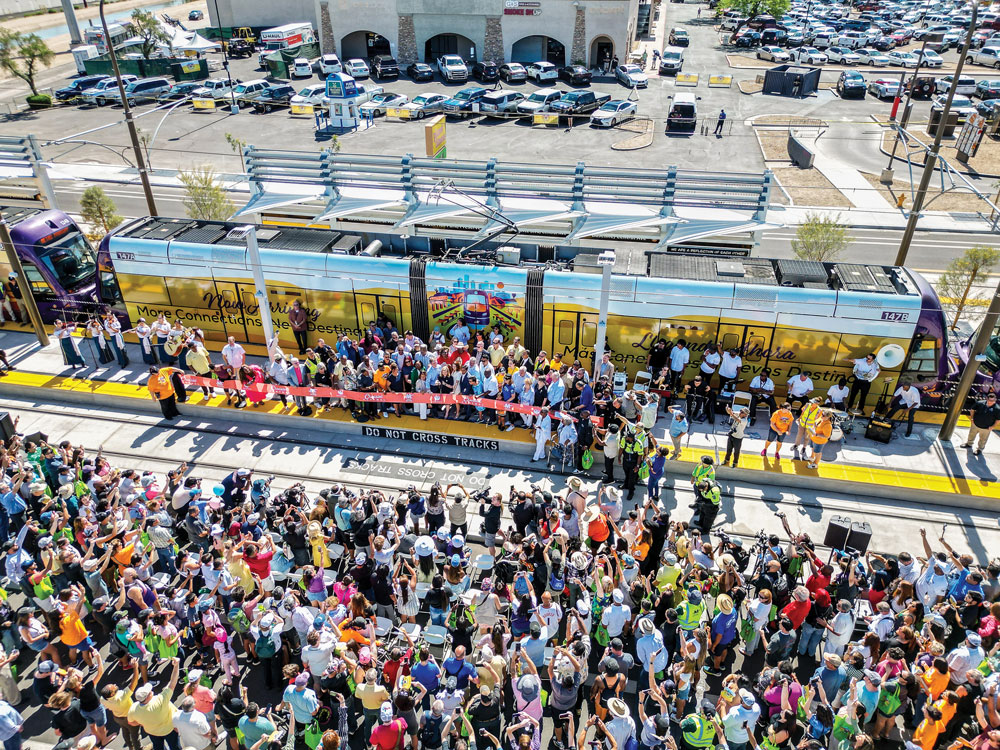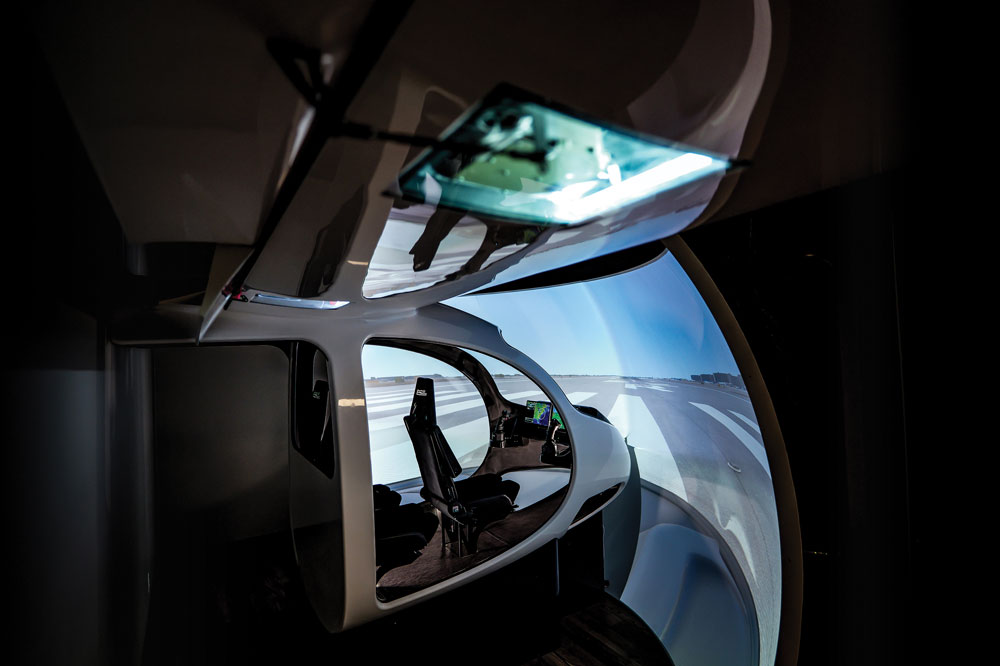In metro Phoenix, novel ways to get from point A to point B start up as frequently as … well … the region’s startups themselves, which have made the region one of the fastest growing startup ecosystems and tech talent hotbeds.
Just pick your mode and hit the road … or rail … or airways, as the case may be.
That last path was made smoother in 2025 by the passage of SB 1307, which establishes infrastructure for the electric vertical take-off and landing (eVTOL) sector and was spurred by an advanced air mobility (AAM) conference held in 2024 by the Greater Phoenix Economic Council.
For evidence of how legislation can spur innovation, look no further than Honeywell Aerospace, whose Phoenix roots go back to the 1956 arrival of the aeronautical division of the Sperry Gyroscope Company in the years following federal initiatives after World War II to geographically disperse the nation’s industrial base.
Honeywell Aerospace’s range of businesses today encompasses everything from electronics, navigation and avionics to propulsion engines, mechanical systems, life support systems, unmanned aerial systems (UAS) and the urban air mobility sector supported by that new law. The company, which saw 2022 sales of $11.8 billion, serves airlines and cargo, business and general aviation; defense; helicopters; space; and emerging transportation solutions.

David Shilliday
The business makes propulsion engines for business jets and auxiliary power units for every 737 or A320 you’ve ever flown on. Because of the heavy defense work, some work areas have to be separated for security reasons to allow the company to control non-U.S. citizens’ access. “Right now we are in peak commercial and peak defense demand, so all of our sites are bursting at the seams relative to capacity,” says David Shilliday, vice president and general manager of Urban Air Mobility and Uncrewed Aerial Systems at Honeywell’s Aerospace Technologies business segment. “Adding AAM on top of it will demand volumes we’ve never produced.”
Today Honeywell Aerospace operates seven facilities in Arizona and employs nearly 7,000 people. But there’s always room for more.
“We want to expand,” Shilliday says. “What we do about it is the next critical step. As we go through the next couple of years, that landscape will become clearer,” especially as Honeywell Aerospace breaks off from the corporate parent next year.

Waymo vehicles fresh from the assembly and technology integration line at the Mesa plant the company operates with Magna can drive themselves out of the factory and be picking up their first Phoenix-area passengers within 30 minutes.
Photos courtesy of Waymo

The business struggled on the workforce front after the pandemic, he says, with a lot of retirements in the aerospace and defense sector. “Trying to keep those operations running was a huge challenge for us,” he says. Partnerships with the Arizona Commerce Authority and GPEC have helped since, producing, among others, 50 full-time employees out of high school intern programs. “That’s huge,” he says. “Those are critical roles for us.”
What would help even more would be more aerospace companies. Shilliday envisions a bill that declares aerospace as a critical industry and a driver of growth and creates a regulatory and incentives framework to encourage more aerospace firms to thrive in the state. “We think more companies is a great thing,” he says.
As the leader of Honeywell’s AAM segment, Shilliday says the eVTOL legislation will help advance “an already very healthy advanced air mobility system in Arizona” and help the state compete against other states with similar supportive legislation such as Florida, Ohio and Texas. The framework helps not just Honeywell but companies such as Wisk, which became a Boeing subsidiary in 2023. He sees AAM helping to open up economies in the state, “for example, access to medical care in rural communities, or being able to deliver products over challenging geographies.”
A recent company newsletter noted that 26 electric Vertical Takeoff and Landing (eVTOL) companies have booked 12,000 orders, and the AAM market has grown to $10 billion.
The pace of product development is also unprecedented in next-gen aerospace, Shilliday says. “And then we have to be agile. It’s not going to be like a 737 where the same design will endure for 30 or 40 years.” All of which puts a premium on developing an agile, flexible, creative and disciplined workforce. “Because we’re growing in Arizona and we’re such a big part of the aerospace ecosystem, we have to develop a lot of the workforce of the future,” Shilliday says. That means more manufacturing and assembly technicians.
Among other programs, the Honeywell Aerospace Technologies team worked closely with Paradise Valley High School’s CREST robotics team at the Fourth Annual Futureshaper Robotics Competition at Chase Field, hosted in partnership with the Arizona Diamondbacks. Partnerships with community colleges and state universities include deployment of advanced manufacturing 3D printing equipment, as well as a Honeywell innovation hub at Arizona State University that allows engineers-in-development to try to solve critical advanced manufacturing problems. “How can AI help us get to higher yield, more manufacturable products?” Shilliday asks. “It’s all allowing us to squeeze more out of existing factories.” The company also partners with ASU’s Polytechnic School in an incubator-style course.
Among other initiatives, Honeywell is a partner in the Future48 Workforce Accelerator launched by Governor Katie Hobbs, which provides hands-on training for careers in aerospace and defense manufacturing. Honeywell collaborates with Maricopa Community Colleges. And Honeywell Aerospace Technologies offers unique learning experiences at Embry-Riddle Aeronautical University’s Phoenix facility, immersing students in hands-on learning related to aviation and aerospace.
Honeywell is partnering with ElevateEd to improve STEM education in Arizona, including high school internship programs, and is collaborating with Mesa Public Schools and Maricopa Community College District on a new workforce and education program to strengthen the connection between classroom experiences, curriculum and instruction to industry.
Taking Off on the Ground
Mobility innovation is not restricted to metro Phoenix airspace. Take the manufacturing site in Casa Grande operated by Calfornia-based Lucid Motors, which in September welcomed a $300 million investment in the company by Uber Technologies as part of a next-generation robotaxi program that calls for the vehicle’s manufacture at the Arizona facility. Uber aims to deploy 20,000 or more Lucid vehicles through the program over six years. Lucid also has taken over facilities and offered employment to more than 300 employees of the recently bankrupted Nikoa Corporation, which had facilities in Coolidge and Phoenix.
For several years Phoenix already has been a robotaxi market for Waymo: Anyone can hail a Waymo One ride across more than 225 square miles. But the company’s present in a more concrete and futuristic way too. In May the company announced a new 239,000-sq.-ft. autonomous vehicle factory in Mesa in partnership with Magna. “The Waymo Driver integration plant in Mesa is the epicenter of our future growth plans,” said Waymo Vice President of Operations Ryan McNamara. “With our partners at Magna, we’ve opened a manufacturing site that enables the cost efficiency, flexibility, and capacity to scale our fleet to new heights.

Transit innovation recently took the form of 5,000 people turning out for the June 2025 grand opening of the $1.34 billion South Central Extension/Downtown Hub (SCE/DH) light rail expansion in Phoenix by Valley Metro Rail. The 5.5-mile extension marks the system’s evolution to a 35-mile two-line rail system.
Photo courtesy of Valley Metro Rail
And get this: Because of the nature of the end product and because validation and commissioning of the autonomous technology occurs at the plant, vehicles coming out the door that happen to be assigned to Waymo’s Phoenix fleet can drive themselves out of the facility and pick up their first public passengers less than 30 minutes later.
Autonomous and EV innovation is afoot in the higher education space too. Western Maricopa Education Center (West-MEC) recently broke ground on a new $13.5 million Advanced Manufacturing and Welding building and EV bay addition to the Northeast campus in Phoenix.
“Advanced manufacturing and electric vehicle technology are becoming increasingly prevalent in today’s STEM career programs and are skills needed by businesses in Arizona and elsewhere,” said Tyler Shupe, project director for McCarthy Building Companies, which is constructing the facilities. “Being able to help students and train the future workforce for these expanding industries makes projects like this incredibly rewarding for us.”

